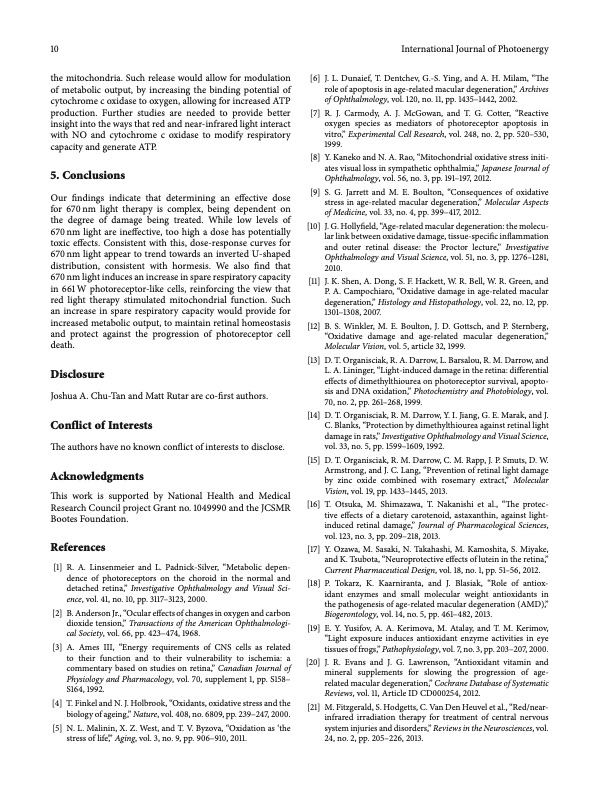
PDF Publication Title:
Text from PDF Page: 011
10 International Journal of Photoenergy the mitochondria. Such release would allow for modulation of metabolic output, by increasing the binding potential of cytochrome c oxidase to oxygen, allowing for increased ATP production. Further studies are needed to provide better insight into the ways that red and near-infrared light interact with NO and cytochrome c oxidase to modify respiratory capacity and generate ATP. 5. Conclusions Our findings indicate that determining an effective dose for 670nm light therapy is complex, being dependent on the degree of damage being treated. While low levels of 670 nm light are ineffective, too high a dose has potentially toxic effects. Consistent with this, dose-response curves for 670 nm light appear to trend towards an inverted U-shaped distribution, consistent with hormesis. We also find that 670 nm light induces an increase in spare respiratory capacity in 661 W photoreceptor-like cells, reinforcing the view that red light therapy stimulated mitochondrial function. Such an increase in spare respiratory capacity would provide for increased metabolic output, to maintain retinal homeostasis and protect against the progression of photoreceptor cell death. Disclosure Joshua A. Chu-Tan and Matt Rutar are co-first authors. Conflict of Interests The authors have no known conflict of interests to disclose. Acknowledgments This work is supported by National Health and Medical Research Council project Grant no. 1049990 and the JCSMR Bootes Foundation. References [1] R. A. Linsenmeier and L. Padnick-Silver, “Metabolic depen- dence of photoreceptors on the choroid in the normal and detached retina,” Investigative Ophthalmology and Visual Sci- ence, vol. 41, no. 10, pp. 3117–3123, 2000. [2] B.AndersonJr.,“Oculareffectsofchangesinoxygenandcarbon dioxide tension,” Transactions of the American Ophthalmologi- cal Society, vol. 66, pp. 423–474, 1968. [3] A. Ames III, “Energy requirements of CNS cells as related to their function and to their vulnerability to ischemia: a commentary based on studies on retina,” Canadian Journal of Physiology and Pharmacology, vol. 70, supplement 1, pp. S158– S164, 1992. [4] T.FinkelandN.J.Holbrook,“Oxidants,oxidativestressandthe biology of ageing,” Nature, vol. 408, no. 6809, pp. 239–247, 2000. [5] N. L. Malinin, X. Z. West, and T. V. Byzova, “Oxidation as ‘the stress of life’,” Aging, vol. 3, no. 9, pp. 906–910, 2011. [6] J. L. Dunaief, T. Dentchev, G.-S. Ying, and A. H. Milam, “The role of apoptosis in age-related macular degeneration,” Archives of Ophthalmology, vol. 120, no. 11, pp. 1435–1442, 2002. [7] R. J. Carmody, A. J. McGowan, and T. G. Cotter, “Reactive oxygen species as mediators of photoreceptor apoptosis in vitro,” Experimental Cell Research, vol. 248, no. 2, pp. 520–530, 1999. [8] Y. Kaneko and N. A. Rao, “Mitochondrial oxidative stress initi- ates visual loss in sympathetic ophthalmia,” Japanese Journal of Ophthalmology, vol. 56, no. 3, pp. 191–197, 2012. [9] S. G. Jarrett and M. E. Boulton, “Consequences of oxidative stress in age-related macular degeneration,” Molecular Aspects of Medicine, vol. 33, no. 4, pp. 399–417, 2012. [10] J.G.Hollyfield,“Age-relatedmaculardegeneration:themolecu- lar link between oxidative damage, tissue-specific inflammation and outer retinal disease: the Proctor lecture,” Investigative Ophthalmology and Visual Science, vol. 51, no. 3, pp. 1276–1281, 2010. [11] J. K. Shen, A. Dong, S. F. Hackett, W. R. Bell, W. R. Green, and P. A. Campochiaro, “Oxidative damage in age-related macular degeneration,” Histology and Histopathology, vol. 22, no. 12, pp. 1301–1308, 2007. [12] B. S. Winkler, M. E. Boulton, J. D. Gottsch, and P. Sternberg, “Oxidative damage and age-related macular degeneration,” Molecular Vision, vol. 5, article 32, 1999. [13] D.T.Organisciak,R.A.Darrow,L.Barsalou,R.M.Darrow,and L. A. Lininger, “Light-induced damage in the retina: differential effects of dimethylthiourea on photoreceptor survival, apopto- sis and DNA oxidation,” Photochemistry and Photobiology, vol. 70, no. 2, pp. 261–268, 1999. [14] D. T. Organisciak, R. M. Darrow, Y. I. Jiang, G. E. Marak, and J. C. Blanks, “Protection by dimethylthiourea against retinal light damage in rats,” Investigative Ophthalmology and Visual Science, vol. 33, no. 5, pp. 1599–1609, 1992. [15] D. T. Organisciak, R. M. Darrow, C. M. Rapp, J. P. Smuts, D. W. Armstrong, and J. C. Lang, “Prevention of retinal light damage by zinc oxide combined with rosemary extract,” Molecular Vision, vol. 19, pp. 1433–1445, 2013. [16] T. Otsuka, M. Shimazawa, T. Nakanishi et al., “The protec- tive effects of a dietary carotenoid, astaxanthin, against light- induced retinal damage,” Journal of Pharmacological Sciences, vol. 123, no. 3, pp. 209–218, 2013. [17] Y. Ozawa, M. Sasaki, N. Takahashi, M. Kamoshita, S. Miyake, and K. Tsubota, “Neuroprotective effects of lutein in the retina,” Current Pharmaceutical Design, vol. 18, no. 1, pp. 51–56, 2012. [18] P. Tokarz, K. Kaarniranta, and J. Blasiak, “Role of antiox- idant enzymes and small molecular weight antioxidants in the pathogenesis of age-related macular degeneration (AMD),” Biogerontology, vol. 14, no. 5, pp. 461–482, 2013. [19] E. Y. Yusifov, A. A. Kerimova, M. Atalay, and T. M. Kerimov, “Light exposure induces antioxidant enzyme activities in eye tissues of frogs,” Pathophysiology, vol. 7, no. 3, pp. 203–207, 2000. [20] J. R. Evans and J. G. Lawrenson, “Antioxidant vitamin and mineral supplements for slowing the progression of age- related macular degeneration,” Cochrane Database of Systematic Reviews, vol. 11, Article ID CD000254, 2012. [21] M.Fitzgerald,S.Hodgetts,C.VanDenHeuveletal.,“Red/near- infrared irradiation therapy for treatment of central nervous system injuries and disorders,” Reviews in the Neurosciences, vol. 24, no. 2, pp. 205–226, 2013.PDF Image | 670 nm Light Therapy to Protect vs Photoreceptor Cell Death

PDF Search Title:
670 nm Light Therapy to Protect vs Photoreceptor Cell DeathOriginal File Name Searched:
Efficacy_of_670_nm_Light_Therapy_to_Protect_agains.pdfDIY PDF Search: Google It | Yahoo | Bing
Cruise Ship Reviews | Luxury Resort | Jet | Yacht | and Travel Tech More Info
Cruising Review Topics and Articles More Info
Software based on Filemaker for the travel industry More Info
The Burgenstock Resort: Reviews on CruisingReview website... More Info
Resort Reviews: World Class resorts... More Info
The Riffelalp Resort: Reviews on CruisingReview website... More Info
| CONTACT TEL: 608-238-6001 Email: greg@cruisingreview.com | RSS | AMP |